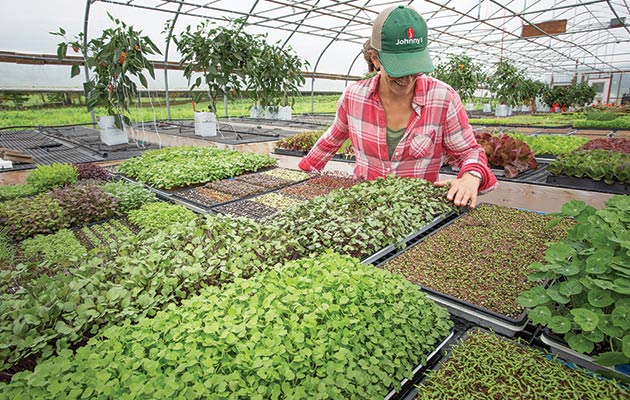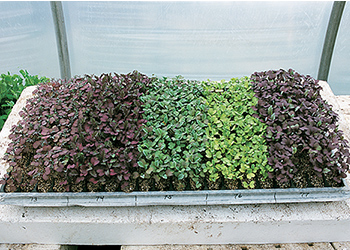Which Microgreens Are Cut and Come Again

Guide to Assisting Year-Round Microgreens Production: Recommendations from Johnny's Research Team
Planning • Sowing • Growing • Harvesting • Marketing
Starting or expanding a microgreens business offers a grower the opportunity to leverage existing markets and open new ones. Microgreens varieties can be marketed profitably as individual components or in signature blends, combining unlike flavors, colors, and textures. They can be quickly produced twelvemonth-circular, fifty-fifty at high latitudes through the depths of winter, with supplemental rut and lighting. In improver to their versatility and potential profitability, microgreens are food-dumbo, intensely flavorful, and but cute.
While microgreens are relatively easy and quick to grow, and start-up costs relatively depression, commercial success depends on knowing some important points up front end. This guide will aid you on your way with planning considerations; the nuts of seed option, sowing, growing, and harvesting; and recommendations for marketing this profitable, year-round specialty crop.
1 • Planning

20-Row tray of 5 varieties, selected for their like growth rate, plus a range of colors, flavors, and textures
SEED SELECTION
You may desire to start with a few straightforward varieties, or with a professionally premixed selection of microgreens, then diversify later on on. Johnny'south currently offers four premixed options:
- Mild Micro Mix, a balanced combination of mild brassicas, in organic and conventional seed options.
- Spicy Micro Mix, a complement of sharper-tasting varieties, in organic and conventional seed options.
- Rainbow Sprinkles Micro Mix, a brand-a-splash recipe of chard and beets in a rainbow of stalk, leaf, and midvein colors.
- Confetti Radish Micro Mix, an easy, fast, colorful formulation, in organic and conventional seed options.
Our mixes are precisely formulated to produce a range of colors, flavors, and textures with fantabulous loft and compatible growth rates.
Microgreens accept a quick turnaround fourth dimension, but there are differences in growth rate between different types and varieties. The majority of vegetable varieties grown as microgreens are gear up for harvest in about 2 weeks, though the brassicas mustard and radish have a faster growth rate and therefore mature faster than beets, carrots, or chard. Herbs grown as microgreens tend to be insufficiently slow-growing, maturing in 16–25 days. Depending upon types, varieties, and environmental conditions, a product cycle tin be prolonged up to 4 weeks and across.
Use our Microgreens Comparing Chart to become more familiar with the fast-growing and ho-hum-growing groups, along with other distinguishing features, and to help you choose varieties to grow meantime. With practice, sowing times can be coordinated to produce a mix of varieties, all ready for harvest at once, at optimal size and flavor.
To judge the seed quantities that you will need, you lot will demand to consider seeding density, a human relationship we cover in more detail below, under Sowing. Some other part of forecasting how much seed you will need involves approximating the quantity of product that yous need to harvest to meet your market demand. To assistance you compare seed quantities to sow versus potential yield during the planning phase, we created a tech sheet detailing the results of our Microgreens Yield Trial (Averages) for 29 Pop Varieties. With some trialing, good tape-keeping, and repetition, a grower can become adept at estimating seed requirements versus project yield, timing production cycles, and forecasting ROI.
GROWING MICROGREENS INDOORS OR UNDER COVER: SUPPLIES & SPACE
Due to the delicate nature of the production, microgreens are about often grown indoors, in greenhouses or other protective structures. Acceptable temperatures, ventilation, and calorie-free are of import and require additional attention and resources. Before you construct your microgreen set up-up, calculate how much space you lot have or volition need, and gather together a few supplies — many of which you may already have on hand:
- Growing medium. We recommend a soilless mix as the best growing medium for microgreens because whatsoever potting mix that includes compost or soil can increase the chance of soilborne disease. For this reason, the best soil for microgreens is really not soil at all. In addition to soilless mixes, other types of growing media, such as foam sheets or woven textiles, are also available on the market.
- Microgreen trays. Microgreens are frequently sown into standard 1020 flats or 20-row seed flats filled with a light, sterile, soilless mix to a depth of 1½–2".
- Tray covers. Options for roofing the seeds after sowing include paper towels, vermiculite, domed lids, or white plastic trays.
- Heat mats. Available in a range of sizes and materials, with daisy-chaining, timer, and monitoring features, rut mats tin can help provide consistent root-zone temperatures.
- Grow lights. Supplemental light is essential at during off-season production at nearly latitudes and/or when growing indoors.
- Circulation fans. Adequate ventilation is essential for disease prevention.
- Hanging benches. Raised platforms, tables, or hanging benches aid keep plants condom and provide for ergonomics.
With their brusk ingather cycles and minimal to no fertility requirements, microgreens are an fantabulous crop for hydroponic civilization. Run into Introduction to Hydroponic Growing to learn more near systems and equipment for this production method.
Source: https://www.johnnyseeds.com/growers-library/vegetables/microgreens/year-round-micro-greens-production.html
0 Response to "Which Microgreens Are Cut and Come Again"
Post a Comment